Factors Impacting Employment Relationship and Employment Status
VerifiedAdded on 2023/06/03
|6
|1508
|391
AI Summary
This article discusses the factors that impact the employment relationship, including internal and external factors, and the difference between employee, worker, and self-employed. It also emphasizes the importance of determining the employment status for both the employer and the employee to ensure legal compliance and protection of rights.
Contribute Materials
Your contribution can guide someone’s learning journey. Share your
documents today.
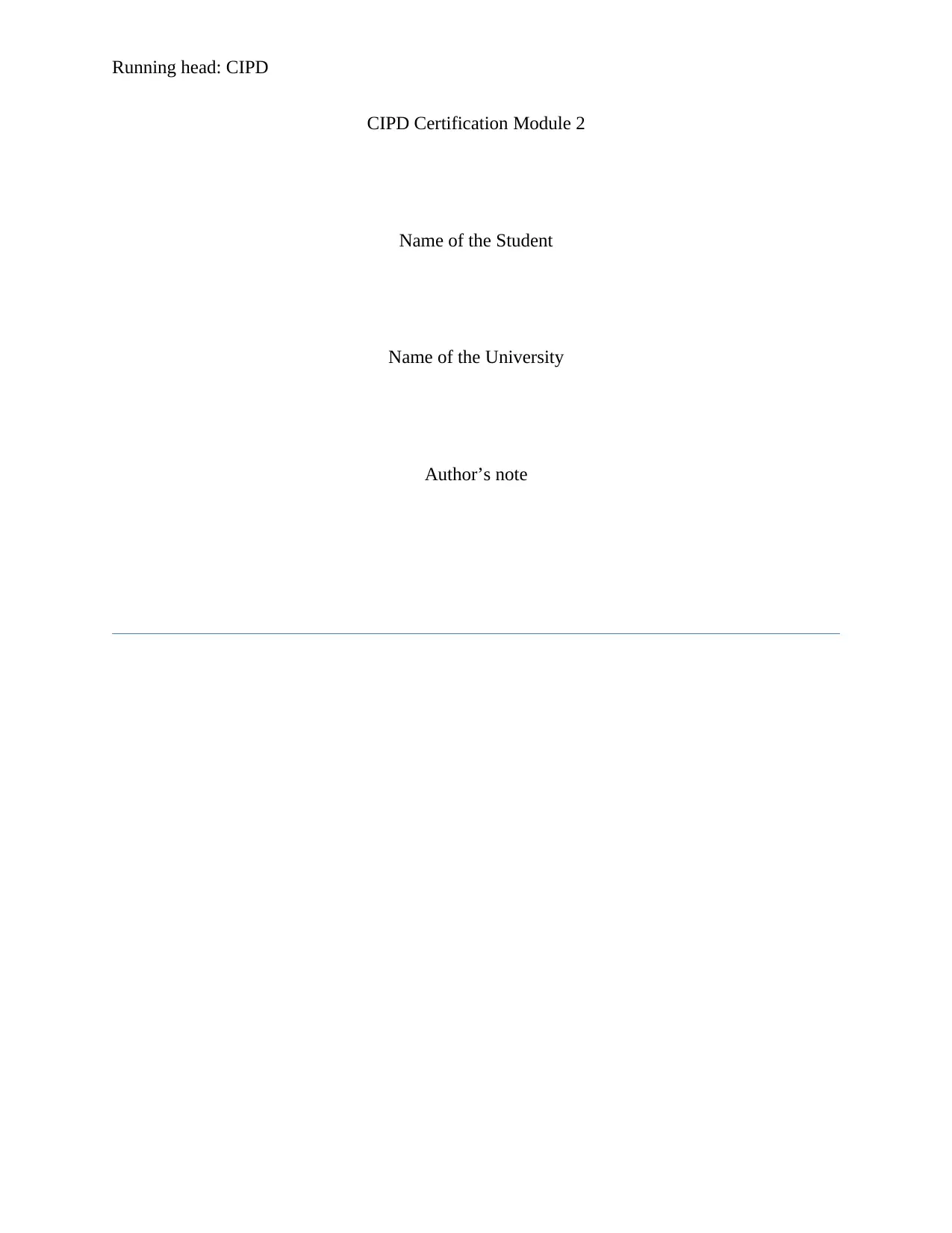
Running head: CIPD
CIPD Certification Module 2
Name of the Student
Name of the University
Author’s note
CIPD Certification Module 2
Name of the Student
Name of the University
Author’s note
Secure Best Marks with AI Grader
Need help grading? Try our AI Grader for instant feedback on your assignments.
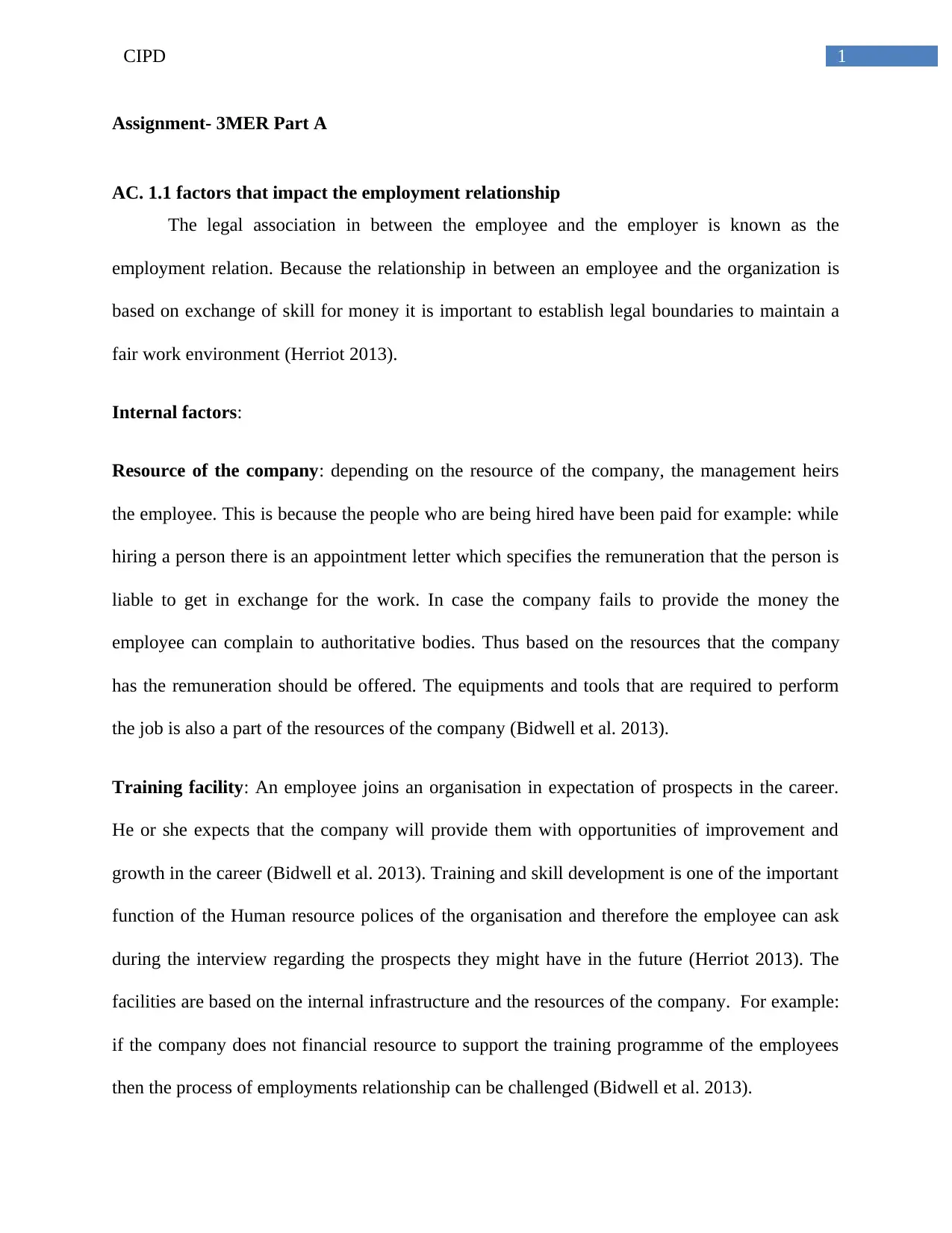
1CIPD
Assignment- 3MER Part A
AC. 1.1 factors that impact the employment relationship
The legal association in between the employee and the employer is known as the
employment relation. Because the relationship in between an employee and the organization is
based on exchange of skill for money it is important to establish legal boundaries to maintain a
fair work environment (Herriot 2013).
Internal factors:
Resource of the company: depending on the resource of the company, the management heirs
the employee. This is because the people who are being hired have been paid for example: while
hiring a person there is an appointment letter which specifies the remuneration that the person is
liable to get in exchange for the work. In case the company fails to provide the money the
employee can complain to authoritative bodies. Thus based on the resources that the company
has the remuneration should be offered. The equipments and tools that are required to perform
the job is also a part of the resources of the company (Bidwell et al. 2013).
Training facility: An employee joins an organisation in expectation of prospects in the career.
He or she expects that the company will provide them with opportunities of improvement and
growth in the career (Bidwell et al. 2013). Training and skill development is one of the important
function of the Human resource polices of the organisation and therefore the employee can ask
during the interview regarding the prospects they might have in the future (Herriot 2013). The
facilities are based on the internal infrastructure and the resources of the company. For example:
if the company does not financial resource to support the training programme of the employees
then the process of employments relationship can be challenged (Bidwell et al. 2013).
Assignment- 3MER Part A
AC. 1.1 factors that impact the employment relationship
The legal association in between the employee and the employer is known as the
employment relation. Because the relationship in between an employee and the organization is
based on exchange of skill for money it is important to establish legal boundaries to maintain a
fair work environment (Herriot 2013).
Internal factors:
Resource of the company: depending on the resource of the company, the management heirs
the employee. This is because the people who are being hired have been paid for example: while
hiring a person there is an appointment letter which specifies the remuneration that the person is
liable to get in exchange for the work. In case the company fails to provide the money the
employee can complain to authoritative bodies. Thus based on the resources that the company
has the remuneration should be offered. The equipments and tools that are required to perform
the job is also a part of the resources of the company (Bidwell et al. 2013).
Training facility: An employee joins an organisation in expectation of prospects in the career.
He or she expects that the company will provide them with opportunities of improvement and
growth in the career (Bidwell et al. 2013). Training and skill development is one of the important
function of the Human resource polices of the organisation and therefore the employee can ask
during the interview regarding the prospects they might have in the future (Herriot 2013). The
facilities are based on the internal infrastructure and the resources of the company. For example:
if the company does not financial resource to support the training programme of the employees
then the process of employments relationship can be challenged (Bidwell et al. 2013).
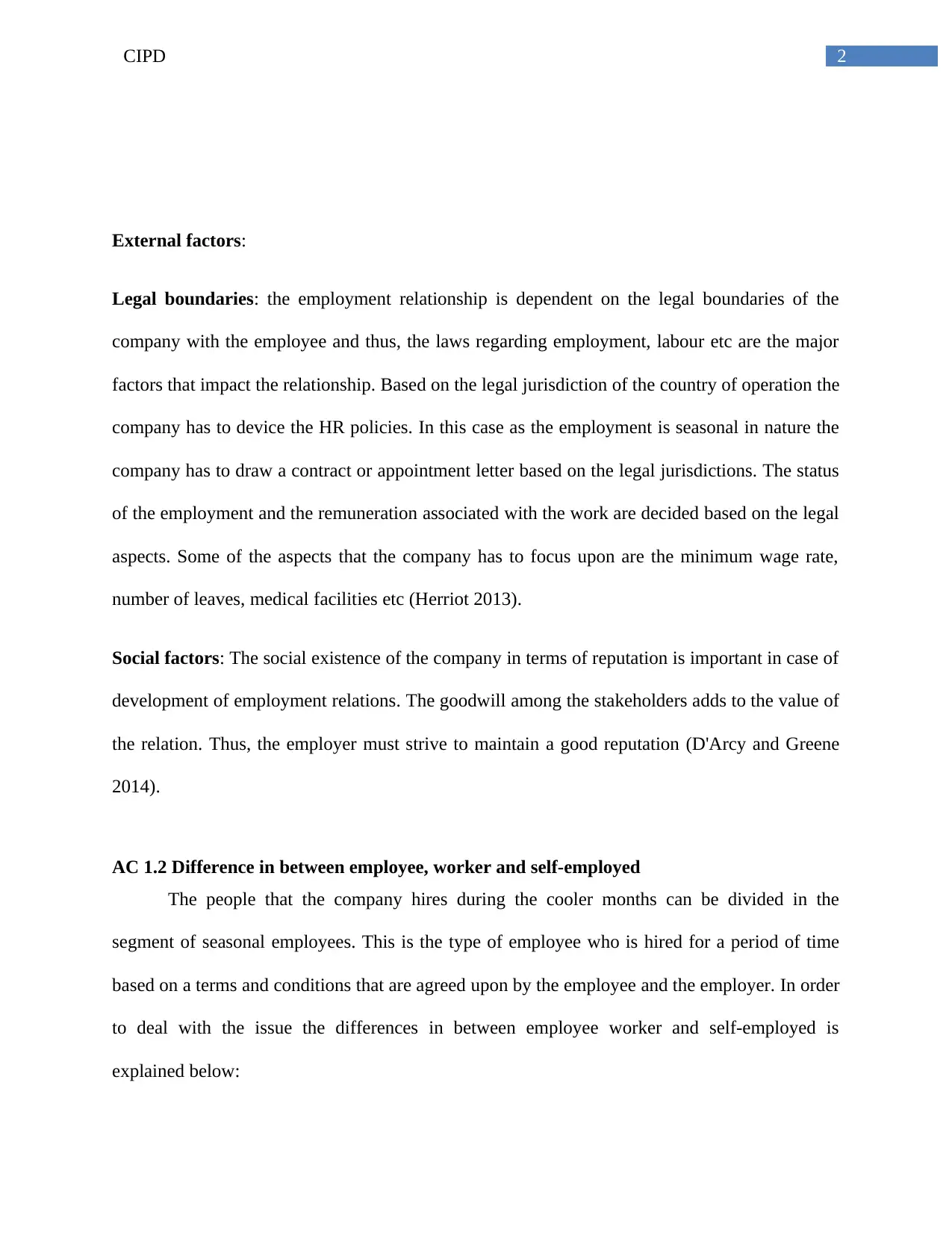
2CIPD
External factors:
Legal boundaries: the employment relationship is dependent on the legal boundaries of the
company with the employee and thus, the laws regarding employment, labour etc are the major
factors that impact the relationship. Based on the legal jurisdiction of the country of operation the
company has to device the HR policies. In this case as the employment is seasonal in nature the
company has to draw a contract or appointment letter based on the legal jurisdictions. The status
of the employment and the remuneration associated with the work are decided based on the legal
aspects. Some of the aspects that the company has to focus upon are the minimum wage rate,
number of leaves, medical facilities etc (Herriot 2013).
Social factors: The social existence of the company in terms of reputation is important in case of
development of employment relations. The goodwill among the stakeholders adds to the value of
the relation. Thus, the employer must strive to maintain a good reputation (D'Arcy and Greene
2014).
AC 1.2 Difference in between employee, worker and self-employed
The people that the company hires during the cooler months can be divided in the
segment of seasonal employees. This is the type of employee who is hired for a period of time
based on a terms and conditions that are agreed upon by the employee and the employer. In order
to deal with the issue the differences in between employee worker and self-employed is
explained below:
External factors:
Legal boundaries: the employment relationship is dependent on the legal boundaries of the
company with the employee and thus, the laws regarding employment, labour etc are the major
factors that impact the relationship. Based on the legal jurisdiction of the country of operation the
company has to device the HR policies. In this case as the employment is seasonal in nature the
company has to draw a contract or appointment letter based on the legal jurisdictions. The status
of the employment and the remuneration associated with the work are decided based on the legal
aspects. Some of the aspects that the company has to focus upon are the minimum wage rate,
number of leaves, medical facilities etc (Herriot 2013).
Social factors: The social existence of the company in terms of reputation is important in case of
development of employment relations. The goodwill among the stakeholders adds to the value of
the relation. Thus, the employer must strive to maintain a good reputation (D'Arcy and Greene
2014).
AC 1.2 Difference in between employee, worker and self-employed
The people that the company hires during the cooler months can be divided in the
segment of seasonal employees. This is the type of employee who is hired for a period of time
based on a terms and conditions that are agreed upon by the employee and the employer. In order
to deal with the issue the differences in between employee worker and self-employed is
explained below:

3CIPD
An employee is an individual who has agreed to work with an organisation in order to help them
achieve their objectives. The status of an employee is based on the contract of employment that
is signed at the time of joining. An employee is expected to fulfill all the responsibilities that are
mentioned in the contract on behalf of the remuneration that they are being awarded (Deem et al.
2015).
A worker is a person who is not under a contract, however, he or she is legally bound with the
company and the status of a worker is in between an employee and a self employed person. As
there are less legal aspect associated with the relation, workers enjoy fewer statutory rights than
the employees.
A self employed is the status when a person chooses to work for oneself, there is no employer in
the process, and the individual has his or her own rules and regulations. If a person chooses to
work for an organisation there can be contract or not, this is dependent on the relation with the
employer. A self employed person can be a doctor, an author, a business man etc (Millán et al.
2013).
As the water park is a business organisation that has a legal existence, the people who are
hired to work for the organisation are the employees. There are basically three divisions of
employees: permanent, temporary and seasonal. The company has to develop a contract in order
to hire these people on a temporary or seasonal basis as their requirement fluctuates with time.
AC. 1.3 Importance of determining the employment status
The relationship in between an employer and an employee is based on legal boundaries
and thus, it is important for the organisation to determine the status of the employees because of
the legal aspects that are associated in the relation. The rights of the employees, the security of
An employee is an individual who has agreed to work with an organisation in order to help them
achieve their objectives. The status of an employee is based on the contract of employment that
is signed at the time of joining. An employee is expected to fulfill all the responsibilities that are
mentioned in the contract on behalf of the remuneration that they are being awarded (Deem et al.
2015).
A worker is a person who is not under a contract, however, he or she is legally bound with the
company and the status of a worker is in between an employee and a self employed person. As
there are less legal aspect associated with the relation, workers enjoy fewer statutory rights than
the employees.
A self employed is the status when a person chooses to work for oneself, there is no employer in
the process, and the individual has his or her own rules and regulations. If a person chooses to
work for an organisation there can be contract or not, this is dependent on the relation with the
employer. A self employed person can be a doctor, an author, a business man etc (Millán et al.
2013).
As the water park is a business organisation that has a legal existence, the people who are
hired to work for the organisation are the employees. There are basically three divisions of
employees: permanent, temporary and seasonal. The company has to develop a contract in order
to hire these people on a temporary or seasonal basis as their requirement fluctuates with time.
AC. 1.3 Importance of determining the employment status
The relationship in between an employer and an employee is based on legal boundaries
and thus, it is important for the organisation to determine the status of the employees because of
the legal aspects that are associated in the relation. The rights of the employees, the security of
Paraphrase This Document
Need a fresh take? Get an instant paraphrase of this document with our AI Paraphraser
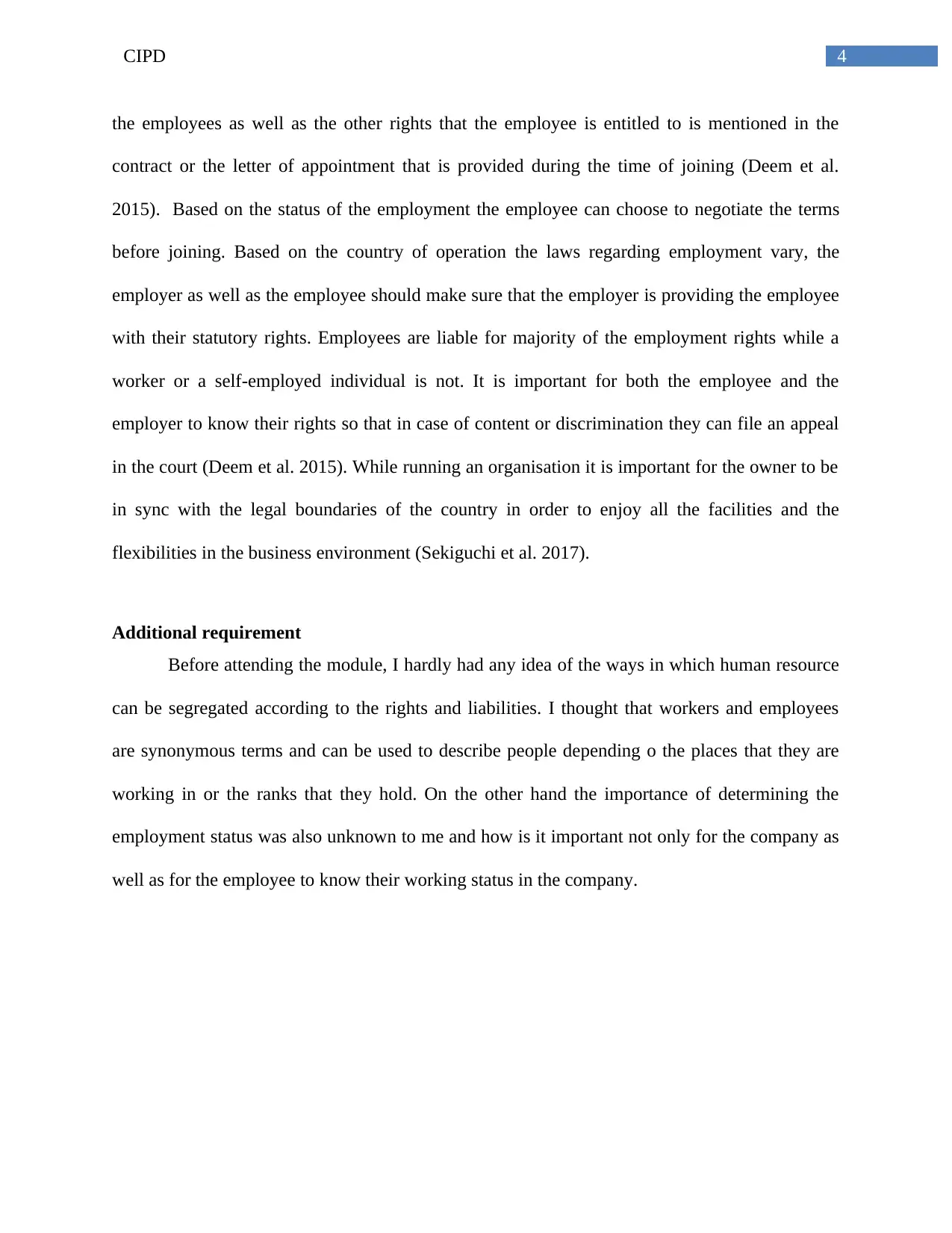
4CIPD
the employees as well as the other rights that the employee is entitled to is mentioned in the
contract or the letter of appointment that is provided during the time of joining (Deem et al.
2015). Based on the status of the employment the employee can choose to negotiate the terms
before joining. Based on the country of operation the laws regarding employment vary, the
employer as well as the employee should make sure that the employer is providing the employee
with their statutory rights. Employees are liable for majority of the employment rights while a
worker or a self-employed individual is not. It is important for both the employee and the
employer to know their rights so that in case of content or discrimination they can file an appeal
in the court (Deem et al. 2015). While running an organisation it is important for the owner to be
in sync with the legal boundaries of the country in order to enjoy all the facilities and the
flexibilities in the business environment (Sekiguchi et al. 2017).
Additional requirement
Before attending the module, I hardly had any idea of the ways in which human resource
can be segregated according to the rights and liabilities. I thought that workers and employees
are synonymous terms and can be used to describe people depending o the places that they are
working in or the ranks that they hold. On the other hand the importance of determining the
employment status was also unknown to me and how is it important not only for the company as
well as for the employee to know their working status in the company.
the employees as well as the other rights that the employee is entitled to is mentioned in the
contract or the letter of appointment that is provided during the time of joining (Deem et al.
2015). Based on the status of the employment the employee can choose to negotiate the terms
before joining. Based on the country of operation the laws regarding employment vary, the
employer as well as the employee should make sure that the employer is providing the employee
with their statutory rights. Employees are liable for majority of the employment rights while a
worker or a self-employed individual is not. It is important for both the employee and the
employer to know their rights so that in case of content or discrimination they can file an appeal
in the court (Deem et al. 2015). While running an organisation it is important for the owner to be
in sync with the legal boundaries of the country in order to enjoy all the facilities and the
flexibilities in the business environment (Sekiguchi et al. 2017).
Additional requirement
Before attending the module, I hardly had any idea of the ways in which human resource
can be segregated according to the rights and liabilities. I thought that workers and employees
are synonymous terms and can be used to describe people depending o the places that they are
working in or the ranks that they hold. On the other hand the importance of determining the
employment status was also unknown to me and how is it important not only for the company as
well as for the employee to know their working status in the company.
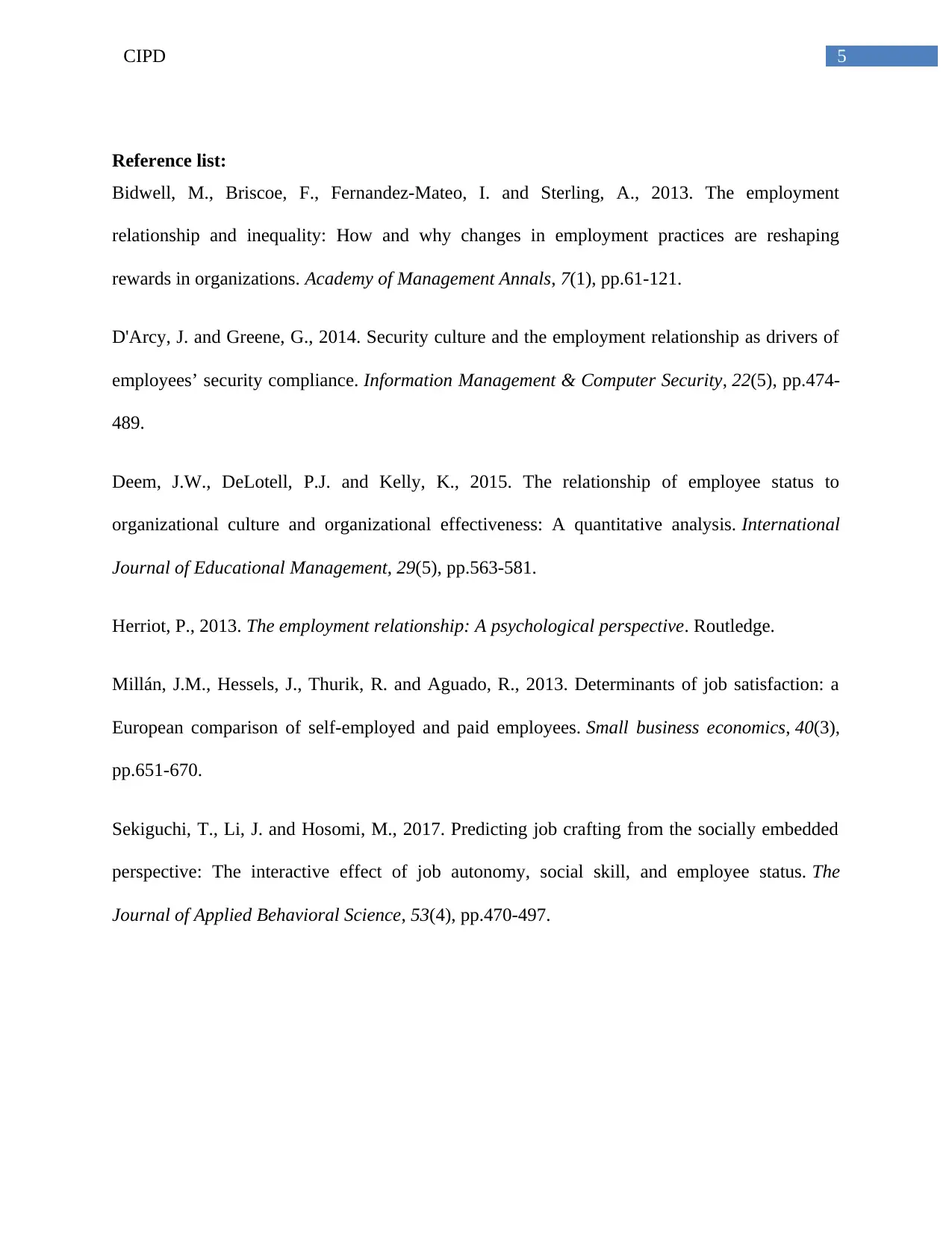
5CIPD
Reference list:
Bidwell, M., Briscoe, F., Fernandez-Mateo, I. and Sterling, A., 2013. The employment
relationship and inequality: How and why changes in employment practices are reshaping
rewards in organizations. Academy of Management Annals, 7(1), pp.61-121.
D'Arcy, J. and Greene, G., 2014. Security culture and the employment relationship as drivers of
employees’ security compliance. Information Management & Computer Security, 22(5), pp.474-
489.
Deem, J.W., DeLotell, P.J. and Kelly, K., 2015. The relationship of employee status to
organizational culture and organizational effectiveness: A quantitative analysis. International
Journal of Educational Management, 29(5), pp.563-581.
Herriot, P., 2013. The employment relationship: A psychological perspective. Routledge.
Millán, J.M., Hessels, J., Thurik, R. and Aguado, R., 2013. Determinants of job satisfaction: a
European comparison of self-employed and paid employees. Small business economics, 40(3),
pp.651-670.
Sekiguchi, T., Li, J. and Hosomi, M., 2017. Predicting job crafting from the socially embedded
perspective: The interactive effect of job autonomy, social skill, and employee status. The
Journal of Applied Behavioral Science, 53(4), pp.470-497.
Reference list:
Bidwell, M., Briscoe, F., Fernandez-Mateo, I. and Sterling, A., 2013. The employment
relationship and inequality: How and why changes in employment practices are reshaping
rewards in organizations. Academy of Management Annals, 7(1), pp.61-121.
D'Arcy, J. and Greene, G., 2014. Security culture and the employment relationship as drivers of
employees’ security compliance. Information Management & Computer Security, 22(5), pp.474-
489.
Deem, J.W., DeLotell, P.J. and Kelly, K., 2015. The relationship of employee status to
organizational culture and organizational effectiveness: A quantitative analysis. International
Journal of Educational Management, 29(5), pp.563-581.
Herriot, P., 2013. The employment relationship: A psychological perspective. Routledge.
Millán, J.M., Hessels, J., Thurik, R. and Aguado, R., 2013. Determinants of job satisfaction: a
European comparison of self-employed and paid employees. Small business economics, 40(3),
pp.651-670.
Sekiguchi, T., Li, J. and Hosomi, M., 2017. Predicting job crafting from the socially embedded
perspective: The interactive effect of job autonomy, social skill, and employee status. The
Journal of Applied Behavioral Science, 53(4), pp.470-497.
1 out of 6
![[object Object]](/_next/static/media/star-bottom.7253800d.svg)


